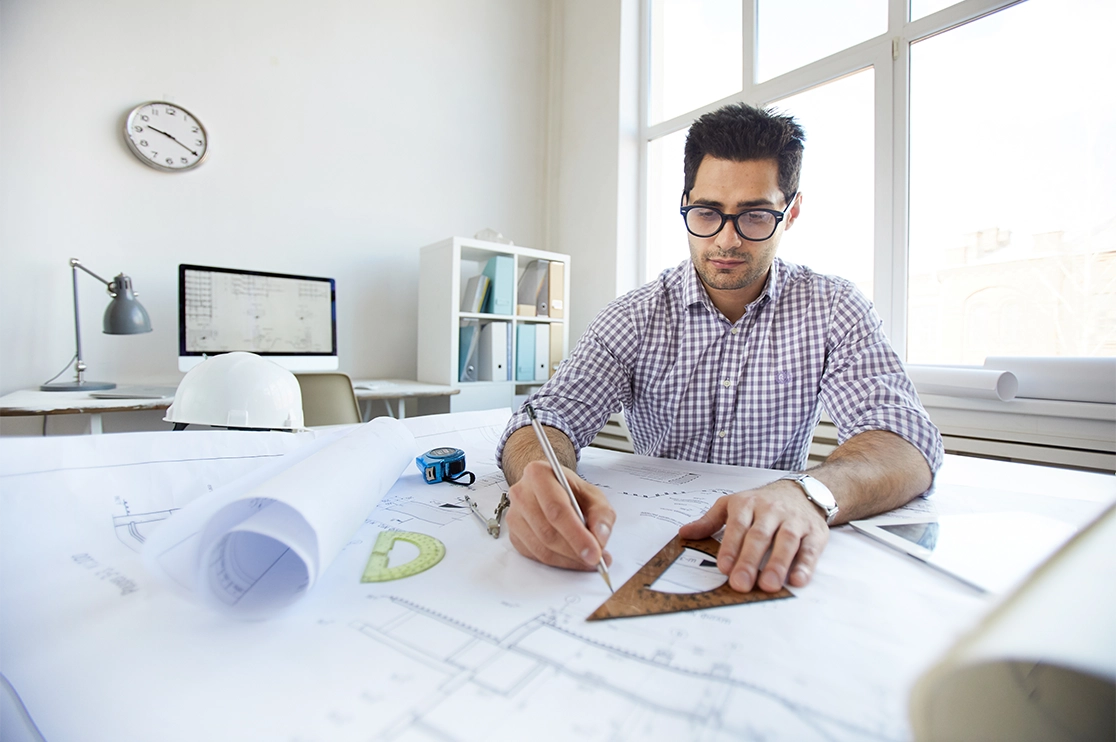Architect Guide to Green Building Materials
Architect Guide to Green Building Materials
Blog Article
Understanding the Diverse Profession Paths Available for Aspiring Architect
As a hopeful Architect, you have a globe of profession paths waiting for you. Whether you're attracted to typical design or the subtleties of lasting layout, there's a niche that lines up with your rate of interests.
Typical Architecture: Designing Buildings and Structures
Conventional design focuses on developing buildings and structures that mix capability with visual charm. Your styles can show cultural heritage, showcasing local practices while fulfilling contemporary requirements.
You'll develop abilities in composing, model-making, and website analysis, allowing you to imagine and connect your concepts properly. Involving with clients, you'll require to understand their vision and translate it right into practical styles.
Additionally, building codes and sustainability techniques are essential in your job, ensuring your structures are secure and ecologically friendly. As you expand in your occupation, you'll find possibilities in household, industrial, or even repair jobs, each offering unique obstacles. Embracing typical design paves the means for a satisfying job that admires the past while forming the future.
Urban Planning: Forming Neighborhoods and Public Spaces
As an aspiring Architect, you can play an important function as a metropolitan planner, transforming exactly how communities work and engage. By using community interaction methods, you'll ensure that homeowners have a voice fit their setting. And also, incorporating sustainable design principles will help develop areas that not only fulfill today's demands however also safeguard the future.
Duty of Urban Planners
While many might consider engineers as the sole visionaries behind structures, city organizers play a necessary role in forming the wider landscape of neighborhoods and public spaces. They examine land use, zoning legislations, and neighborhood requires to develop lasting atmospheres that improve high quality of life. By collaborating with different stakeholders, you'll aid make parks, transportation systems, and houses that advertise social communication and ease of access. Urban planners also focus on ecological considerations, ensuring that developments integrate eco-friendly areas and support biodiversity. Your know-how in spatial layout and community characteristics enables you to envision future development while preserving cultural heritage. In this important duty, you'll straight influence how people experience their environments, making every task an opportunity for positive adjustment.
Area Interaction Strategies
Reliable neighborhood involvement strategies are essential for metropolitan organizers to guarantee that the voices of homeowners are listened to and valued in the planning procedure. To cultivate meaningful dialogue, you need to focus on open discussion forums and workshops where community participants can share their concepts and concerns. Use studies and social media sites to get to a wider audience, guaranteeing diverse perspectives are consisted of. Collaborating with regional organizations can boost depend on and facilitate deeper connections. It is necessary to supply clear info concerning decision-making processes and suggested jobs, permitting homeowners to really feel educated and encouraged. By actively including and paying attention comments, you'll develop rooms that show the neighborhood's requirements, ultimately bring about even more effective and lasting city environments. Welcome openness and constant dialogue for long lasting impact.
Lasting Style Concepts
When making metropolitan areas, integrating sustainable layout concepts is important for producing environments that grow both environmentally and socially. Consider incorporating eco-friendly areas, like yards and parks, to enhance biodiversity and enhance air high quality.
Creating with water preservation in mind is also vital-- assume regarding rain yards and absorptive surfaces to manage stormwater. Involving community members throughout the preparation process assurances that the rooms you create fulfill their demands and motivate social interaction. By welcoming these principles, you'll add to vivid, lasting urban landscapes that profit every person.

Landscape Design: Producing Sustainable Outdoor Atmospheres
As you explore landscape architecture, you'll find crucial layout concepts that produce practical and stunning exterior spaces. Lasting methods play a crucial function in making certain these atmospheres prosper while lessening environmental effect. And also, you'll locate a range of occupation chances that enable you to make a genuine distinction in exactly how individuals engage with nature.
Layout Principles in Landscape
Understanding design principles in landscape architecture is important for developing lasting outside atmospheres that balance with nature. You'll need to consider aspects like balance, proportion, and range to assure your styles feel cohesive and welcoming. In addition, pay interest to seasonal modifications, developing with materials that enhance the environments year-round.
Sustainable Practices Summary
Sustainable techniques in landscape design not only concentrate on visual appeals but additionally prioritize ecological health and source conservation. By integrating indigenous plants, you improve biodiversity and reduce the demand for chemical fertilizers and pesticides. Applying effective irrigation systems aids save water and minimizes overflow, shielding close-by ecosystems. You can make areas that advertise soil health, such as making use of organic products and practicing permaculture concepts. Additionally, including eco-friendly pop over here framework, like rain yards and porous sidewalks, aids in stormwater administration and lowers urban warmth. When you develop outdoor environments with sustainability in mind, you add to a healthier world and provide areas that promote neighborhood connection. Eventually, these methods assure your designs profit both people and the setting for many years to come.
Career Opportunities Exploration
With a strong foundation in sustainable techniques, landscape architecture uses a variety of career courses that enable you to make a significant impact on the setting. You can function as a landscape developer, producing visually visite site pleasing and practical exterior spaces, or concentrate on eco-friendly repair, aiding to restore broken communities. Urban organizers typically team up with landscape engineers to create eco-friendly rooms in metropolitan settings, improving city livability. If you're passionate concerning education, think about coming to be a landscape architecture instructor, inspiring future generations. Additionally, you could deal with nonprofits concentrated on ecological sustainability or involve in research to innovate new methods. Each course not only shapes stunning environments yet additionally cultivates a much healthier world for future generations.
Lasting Style: Concentrating On Eco-Friendly Practices
As you discover your career in style, accepting environment-friendly methods can establish you apart in an affordable field. Lasting style concentrates on creating structures that decrease environmental influence while enhancing resident health. By incorporating sustainable products, energy-efficient systems, and sustainable building strategies, you'll add to a greener future.
Begin by obtaining knowledge of eco-friendly certifications like LEED or BREEAM, which can reinforce your qualifications. Take into consideration how all-natural light, air flow, and thermal efficiency can optimize style. Work together with engineers and environmental consultants to innovate remedies that reduce waste and conserve resources.
Do not neglect the importance of neighborhood participation-- interesting neighborhood stakeholders can inspire designs that harmonize with the atmosphere. As clients increasingly focus on sustainability, your proficiency in environmentally friendly practices will certainly not only attract jobs however also accomplish your enthusiasm for responsible style. Welcome this crucial aspect of the profession, and view your profession thrive.
Historic Preservation: Safeguarding and Bring Back Social Heritage
While you start on your building trip, think about the important role of historical conservation in preserving our cultural heritage. This field concentrates on the security and remediation of substantial buildings, sites, and frameworks that inform the tales of our past. By participating in historic conservation, you'll assist secure the architectural heritage that forms neighborhood identity.
As a historical preservation Architect, you'll examine historical significance and analyze the problem of structures. You'll function closely with preservationists and chroniclers to guarantee genuine reconstruction methods are used. This profession course enables you to blend imagination with study, allowing you to design remedies that value initial products and workmanship.
Your job not only adds to sustainability by reusing existing buildings however additionally fosters a sense of satisfaction within neighborhoods. Welcoming this path will certainly assist you end up being a guardian of history, maintaining the stories and appearances that improve our lives.
Interior Architecture: Enhancing Indoor Spaces
Historic preservation and indoor architecture both share a dedication to boosting the constructed environment, but they read more concentrate on different aspects. While historical preservation emphasizes maintaining a structure's historic and cultural value, interior design nos in on optimizing indoor rooms for functionality and visual appeals.
As a hopeful Architect, you'll find that interior architecture allows you to mix imagination with technological abilities. You'll design rooms that not only look great yet also promote comfort and efficiency. This field includes understanding exactly how light, shade, and materials interact within a space, influencing mood and functionality.
You'll work with numerous jobs, from domestic homes to commercial offices, guaranteeing that each setting satisfies the needs of its occupants. By prioritizing customer experience, you can transform interiors right into practical and inspiring areas, making a considerable influence on exactly how individuals interact with their surroundings. Accept the possibility to enhance indoor environments and form the way people live and work.
Industrial Style: Combining Capability With Aesthetic Appeals
Industrial layout plays an important role in producing items that effortlessly mix looks with functionality, making certain that what you make use of everyday is not only visually appealing however additionally useful. As an aspiring Architect, you can immerse yourself in this field, concentrating on making every little thing from furniture to consumer electronics. Your job includes understanding customer needs, materials, and making procedures, allowing you to produce innovative options that boost everyday experiences.
In commercial layout, you'll often work together with designers, suppliers, and marketers, making sure that your styles are not just beautiful but additionally feasible. This job path offers a vibrant environment where imagination meets usefulness, making it a rewarding selection for architects interested in forming the products of tomorrow.
Frequently Asked Concerns
What Educational Qualifications Do I Required to End Up Being an Architect?
To end up being an engineer, you'll require a specialist degree in style, generally a Bachelor's or Master's. In addition, you'll have to complete an internship and pass the Architect Registration Assessment to practice lawfully.
Exist Certification Requirements for Various Architectural Career Paths?
Yes, there're certification demands for different architectural paths. Architect. You'll require to pass examinations, total internships, and sometimes seek specialized training, depending on your picked emphasis, like landscape style, metropolitan design, or historic conservation
What Software Application Skills Are Essential for Engineers Today?

Just How Can I Gain Practical Experience While Examining Design?
You can acquire useful experience by interning at building firms, getting involved in style competitions, offering for area tasks, or teaming up with schoolmates on real-world jobs. These opportunities boost your abilities and construct valuable links in the market.
What Work Opportunities Exist Outside Typical Design Firms?
You can check out different task opportunities outside traditional style firms, like metropolitan preparation, indoor layout, landscape style, construction management, property advancement, or perhaps roles in sustainability consulting. Each offers special challenges and rewards.
Whether you're drawn to typical architecture or the nuances of lasting design, there's a niche that straightens with your rate of interests.When designing metropolitan spaces, integrating sustainable layout concepts is essential for developing settings that thrive both environmentally and socially.As you check out landscape style, you'll uncover important design concepts that produce gorgeous and practical outside spaces.Understanding design principles in landscape architecture is essential for developing sustainable outside atmospheres that balance with nature.In commercial layout, you'll typically work together with engineers, online marketers, and producers, ensuring that your layouts are not just attractive however additionally feasible.
Report this page